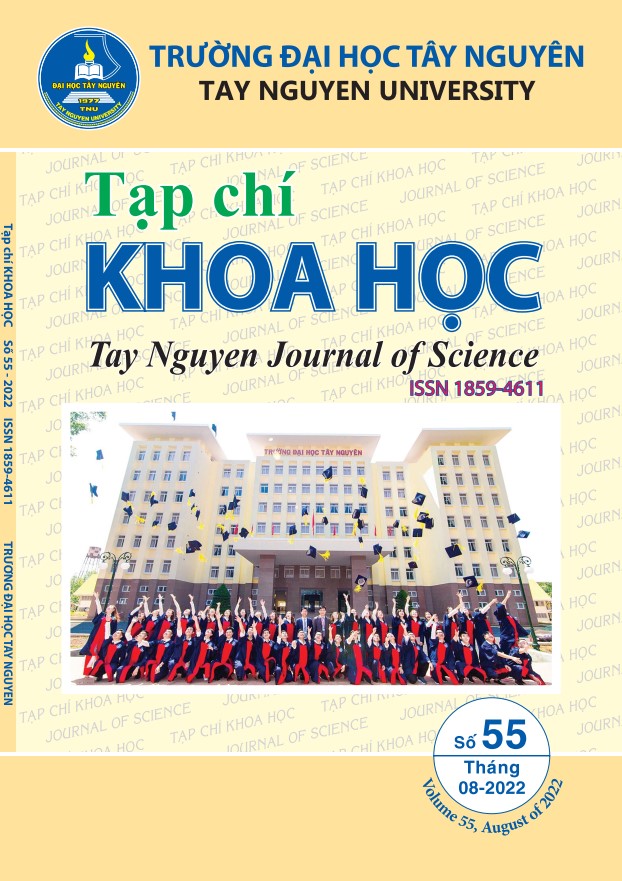Nghiên cứu cấu trúc, độ bền và khả năng hấp phụ trên Graphitic Carbon Nitride (g-C3N4) của Cluster Nickel nhỏ bằng phương pháp phiếm hàm mật độ
Main Article Content
Nghiên cứu cấu trúc, độ bền và khả năng hấp phụ trên Graphitic Carbon Nitride (g-C3N4) của Cluster Nickel nhỏ bằng phương pháp phiếm hàm mật độ
Tóm tắt
Trong những năm gần đây, cluster kim loại chuyển tiếp ngày càng khẳng định được vị thế của mình trong lĩnh vực khoa học và kỹ thuật. Trong các cluster của kim loại chuyển tiếp, cluster nhỏ của nickel rất được quan tâm nghiên cứu cả về lí thuyết và thực nghiệm. Graphitic carbon nitride (g-C3N4) ngày càng trở nên quan trọng do những dự đoán lí thuyết về các đặc tính và ứng dụng đầy hứa hẹn của chúng. Bài báo này nghiên cứu cấu trúc hình học bền vững nhất của các cluster Nin (n = 2-5) và khả năng hấp phụ của các cluster này trên g-C3N4 bằng phương pháp phiếm hàm mật độ liên kết chặt GFN2-xTB. Kết quả đã xác định được cấu trúc hình học ổn định của các cluster Nin (n = 2-5) ứng với một số trạng thái spin xác định (singlet đối với cluster Ni2, Ni3, Ni4 và quintet đối với cluster Ni5). Sự hấp phụ của các cluster nickel nhỏ trên g-C3N4 đều có bản chất là hấp phụ hóa học. Các hệ cluster Ni/g-C3N4 được dự đoán là chất hấp phụ tốt đối với các chất ô nhiễm hữu cơ bền (persistent organic pollutants: POPs), góp phần giải quyết vấn đề ô nhiễm môi trường gây ra bởi POPs.
Article Details

Tác phẩm này được cấp phép theo Giấy phép quốc tế Creative Commons Attribution-NonCommercial-NoDeri Phái sinh 4.0 .
Tài liệu tham khảo
- Bannwarth, C., Ehlert, S., Grimmer, S. ( 2019). GFN2-xTB- an Accurate and Broadly Parametrized SelfConsistent Tight- Binding Quantum Chemical Method with multipole electrostatics and DensityDependent Dispersion Contributions. Chemical Theory and Computation, 15( 3), 1652–1671. doi: https://doi.org/10.1021/acs.jctc.8b01176
- Cheng, L., Yin, H., Cai, C., Fan, J., & Xiang, Q. (2020). Single Ni Atoms Anchored on Porous FewLayer g-C3N4 for Photocatalytic CO2 Reduction: The Role of Edge Confinement. Small, 16(28), 2002411. Retrieved from https://doi.org/10.1002/smll.202002411. doi:https://doi.org/10.1002/smll.202002411
- Fang, Z., Hong, Y., Li, D., Luo, B., Mao, B., & Shi, W. (2018). One-Step Nickel Foam Assisted Synthesis of Holey G-Carbon Nitride Nanosheets for Efficient Visible-Light Photocatalytic H2 Evolution. ACS Applied Materials & Interfaces, 10(24), 20521-20529. Retrieved from https://doi.org/10.1021/acsami.8b04783. doi:10.1021/acsami.8b04783
- Gao, Z., Li, A., Liu, X., Ma, C., Li, X., Yang, W., & Ding, X.-L. (2019). Density functional study of the adsorption of NO on Ni (n = 1, 2, 3 and 4) clusters doped functionalized graphene support. Applied surface science, 481. doi:10.1016/j.apsusc.2019.03.186
- Goel, S., & Masunov, A. E. (2012). Density functional theory study of small nickel clusters. Journal of Molecular Modeling, 18(2), 783-790. Retrieved from https://doi.org/10.1007/s00894-011-1100-x. doi:10.1007/s00894-011-1100-x
- Grigoryan, V., & Springborg, M. (2004). Structural and energetic properties of nickel clusters: 2 <= N <= 150. Physical Review B, 70. doi:10.1103/PhysRevB.70.205415
- Grimme, S., Bannwarth, C., & Shushkov, P. (2017). A Robust and Accurate Tight-Binding Quantum Chemical Method for Structures, Vibrational Frequencies, and Noncovalent Interactions of Large Molecular Systems Parametrized for All spd-Block Elements (Z = 1−86). Chemical Theory and Computation, 13(5), 1989–2009. doi: 10.1021/acs.jctc.7b00118
- Kant, A. (1964). Dissociation Energies of Diatomic Molecules of the Transition Elements. I. Nickel. The Journal of chemical physics, 41(6), 1872-1876. Retrieved from https://doi.org/10.1063/1.1726169. doi:10.1063/1.1726169
- Lan, M., Fan, G., & Yang, L. (2014). Enhanced visible-light-induced photocatalytic performance of a novel ternary semiconductor coupling system based on hybrid Zn–In mixed metal oxide/g-C3N4 composites. RSC Adv., 5. doi:10.1039/C4RA07073A
- López Arvizu, G., & Calaminici, P. (2007). Assessment of density functional theory optimized basis sets for gradient corrected functionals to transition metal systems: the case of small Nin (n
- Luo, C. (2000). Structure of small nickel clusters: Ni2-Ni19. Modelling and Simulation in Materials Science and Engineering, 8, 95. doi:10.1088/0965-0393/8/2/301
- Michelini, M. C., Diez, R. P., & Jubert, A. H. (1999). Density functional calculations of Ni5 and Ni6 clusters. Journal of Molecular Structure: THEOCHEM, 490(1), 181-188. Retrieved from https://www.sciencedirect.com/science/article/pii/S0166128099000901. doi:https://doi.org/10.1016/S0166-1280(99)00090-1
- Moskovits, M., & Hulse, J. E. (1977). The ultraviolet–visible spectra of diatomic, triatomic, and higher nickel clusters. The Journal of chemical physics, 66(9), 3988-3994. Retrieved from https://doi.org/10.1063/1.434451. doi:10.1063/1.434451
- Parks, E. K., Winter, B. J., Klots, T. D., & Riley, S. J. (1991). The structure of nickel clusters. The Journal of chemical physics, 94(3), 1882-1902. Retrieved from https://doi.org/10.1063/1.459910. doi:10.1063/1.459910
- Parks, E. K., Zhu, L., Ho, J., & Riley, S. J. (1994). The Structure of Small Nickel Clusters .1. Ni-3- Ni-15. Journal of Chemical Physics, 100(10), 7206-7222. Retrieved from https://www.cheric.org/research/tech/periodicals/view.php?seq=113743. doi:10.1063/1.466868
- Pracht, P., Bohle, F., & Grimme, S. (2020). Automated exploration of the low-energy chemical space with fast quantum chemical methods. Physical Chemistry Chemical Physics, 22(14), 7169-7192. Retrieved from http://dx.doi.org/10.1039/C9CP06869D. doi:10.1039/C9CP06869D
- St. Petkov, P., Vayssilov, G. N., Krüger, S., & Rösch, N. (2006). Structure, stability, electronic and magnetic properties of Ni4 clusters containing impurity atoms. Physical Chemistry Chemical Physics, 8(11), 1282-1291. Retrieved from http://dx.doi.org/10.1039/B518175E. doi:10.1039/B518175E
- Veldeman, N. (2007). The influence of doping on the physicochemical properties of coinage metal clusters: enhanced stabilities and modified chemical activities.
- Wen, J., Xie, J., Chen, X., & Li, X. (2017). A review on g-C3N4-based photocatalysts. Applied surface science, 391, 72-123.
- Xie, Z., Ma, Q.-M., Liu, Y., & Li, Y.-C. (2005). First-principles study of the stability and Jahn– Teller distortion of nickel clusters. Physics Letters A, 342(5), 459-467. Retrieved from https://www.sciencedirect.com/science/article/pii/S0375960105007875. doi:https://doi.org/10.1016/j.physleta.2005.05.067
- Yan, S., Jiang, H., Yang, Z., & Zhu, Z. (2012). Density functional theory study of small Nin(n≤8) clusters. Journal of Atomic and Molecular Physics, 29(2), 281-290. Retrieved from http://inis.iaea.org/search/search.aspx?orig_q=RN:46127319



